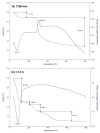Synthesis, characterization, and antibacterial activity of cross-linked chitosan-glutaraldehyde
- PMID: 23670533
- PMCID: PMC3707160
- DOI: 10.3390/md11051534
Synthesis, characterization, and antibacterial activity of cross-linked chitosan-glutaraldehyde
Abstract
This present study deals with synthesis, characterization and antibacterial activity of cross-linked chitosan-glutaraldehyde. Results from this study indicated that cross-linked chitosan-glutaraldehyde markedly inhibited the growth of antibiotic-resistant Burkholderia cepacia complex regardless of bacterial species and incubation time while bacterial growth was unaffected by solid chitosan. Furthermore, high temperature treated cross-linked chitosan-glutaraldehyde showed strong antibacterial activity against the selected strain 0901 although the inhibitory effects varied with different temperatures. In addition, physical-chemical and structural characterization revealed that the cross-linking of chitosan with glutaraldehyde resulted in a rougher surface morphology, a characteristic Fourier transform infrared (FTIR) band at 1559 cm⁻¹, a specific X-ray diffraction peak centered at 2θ = 15°, a lower contents of carbon, hydrogen and nitrogen, and a higher stability of glucose units compared to chitosan based on scanning electron microscopic observation, FTIR spectra, X-ray diffraction pattern, as well as elemental and thermo gravimetric analysis. Overall, this study indicated that cross-linked chitosan-glutaraldehyde is promising to be developed as a new antibacterial drug.
Figures





Similar articles
-
Physicochemical characterization of chitosan/nylon6/polyurethane foam chemically cross-linked ternary blends.Spectrochim Acta A Mol Biomol Spectrosc. 2013 Mar 15;105:20-3. doi: 10.1016/j.saa.2012.12.012. Epub 2012 Dec 14. Spectrochim Acta A Mol Biomol Spectrosc. 2013. PMID: 23291196
-
Preparation and characterization of uniform-sized chitosan/silver microspheres with antibacterial activities.Mater Sci Eng C Mater Biol Appl. 2014 Mar 1;36:33-41. doi: 10.1016/j.msec.2013.11.037. Epub 2013 Dec 5. Mater Sci Eng C Mater Biol Appl. 2014. PMID: 24433884
-
Physicochemical and bioactivity of cross-linked chitosan-PVA film for food packaging applications.Int J Biol Macromol. 2009 Nov 1;45(4):372-6. doi: 10.1016/j.ijbiomac.2009.07.006. Epub 2009 Jul 28. Int J Biol Macromol. 2009. PMID: 19643129
-
Synthesis, characterization, and antibacterial activity of chitosan/TiO2 nanocomposite against Xanthomonas oryzae pv. oryzae.Carbohydr Polym. 2016 Nov 5;152:825-831. doi: 10.1016/j.carbpol.2016.07.070. Epub 2016 Jul 19. Carbohydr Polym. 2016. PMID: 27516334
-
Highly luminescent chitosan-L-cysteine functionalized CdTe quantum dots film: synthesis and characterization.Carbohydr Polym. 2013 Sep 12;97(2):327-34. doi: 10.1016/j.carbpol.2013.04.056. Epub 2013 May 15. Carbohydr Polym. 2013. PMID: 23911453
Cited by
-
Corrigendum: Applications of chitosan and its derivatives in skin and soft tissue diseases.Front Bioeng Biotechnol. 2022 Nov 25;10:1082945. doi: 10.3389/fbioe.2022.1082945. eCollection 2022. Front Bioeng Biotechnol. 2022. PMID: 36507275 Free PMC article.
-
Development of a Diatom-Based Photoluminescent Immunosensor for the Early Detection of Karnal Bunt Disease of Wheat Crop.ACS Omega. 2020 Apr 2;5(14):8251-8257. doi: 10.1021/acsomega.0c00551. eCollection 2020 Apr 14. ACS Omega. 2020. PMID: 32309735 Free PMC article.
-
Improving the antibacterial properties of polyethylene food packaging films with Ajwain essential oil adsorbed on chitosan particles.Sci Rep. 2024 Nov 20;14(1):28802. doi: 10.1038/s41598-024-80349-7. Sci Rep. 2024. PMID: 39567677 Free PMC article.
-
Physical and Structural Properties of Chitosan-Squid Gelatin Hydrogels.Gels. 2025 Feb 3;11(2):109. doi: 10.3390/gels11020109. Gels. 2025. PMID: 39996652 Free PMC article.
-
Recent modifications of chitosan for adsorption applications: a critical and systematic review.Mar Drugs. 2015 Jan 9;13(1):312-37. doi: 10.3390/md13010312. Mar Drugs. 2015. PMID: 25584681 Free PMC article.
References
-
- Vanlaere E., Lipuma J.J., Baldwin A., Henry D., De Brandt E., Mahenthiralingam E., Speert D., Dowson C., Vandamme P. Burkholderia latens sp. nov., Burkholderia diffusa sp. nov., Burkholderia arboris sp. nov., Burkholderia seminalis sp. nov. and Burkholderia metallica sp. nov., novel species within the Burkholderia cepacia complex. Int. J. Syst. Evol. Microbiol. 2008;58:1580–1590. doi: 10.1099/ijs.0.65634-0. - DOI - PubMed
-
- Vanlaere E., Baldwin A., Gevers D., Henry D., Brandt E.D., LiPuma J.J. Taxon K, a complex within the Burkholderia cepacia complex, comprises at least two novel species: Burkholderia contaminans sp. nov. and Burkholderia lata sp. nov. Int. J. Syst. Evol. Microbiol. 2009;59:102–111. doi: 10.1099/ijs.0.001123-0. - DOI - PubMed
-
- Fang Y., Lou M.M., Li B., Xie G.L., Wang F., Zhang L.X., Luo Y.C. Characterization of Burkholderia cepacia complex from cystic fibrosis patients in China and their chitosan susceptibility. World J. Microbiol. Biotechnol. 2010;26:443–450. doi: 10.1007/s11274-009-0187-z. - DOI
Publication types
MeSH terms
Substances
LinkOut - more resources
Full Text Sources
Other Literature Sources
Medical

